Risk Factors for Depression and Bipolar Disorder: Counseling Report
VerifiedAdded on 2022/08/25
|7
|1479
|17
Report
AI Summary
This report provides an overview of depression and bipolar disorder, focusing on their associated risk factors. It begins by defining major depression as a mood disorder characterized by persistent sadness and loss of interest, and bipolar disorder as a condition with extreme mood swings. The report then delves into the risk factors for major depression, including gender, marital status, life events, early trauma, general medical illnesses, and social class. It also explores the risk factors for bipolar disorder, such as genetic and family factors, environmental factors, childhood maltreatment, and substance misuse. The analysis incorporates data from various studies and research papers, offering a comprehensive understanding of the factors contributing to these mental health conditions. The report references key studies and provides evidence-based insights into the prevalence and potential causes of these disorders.
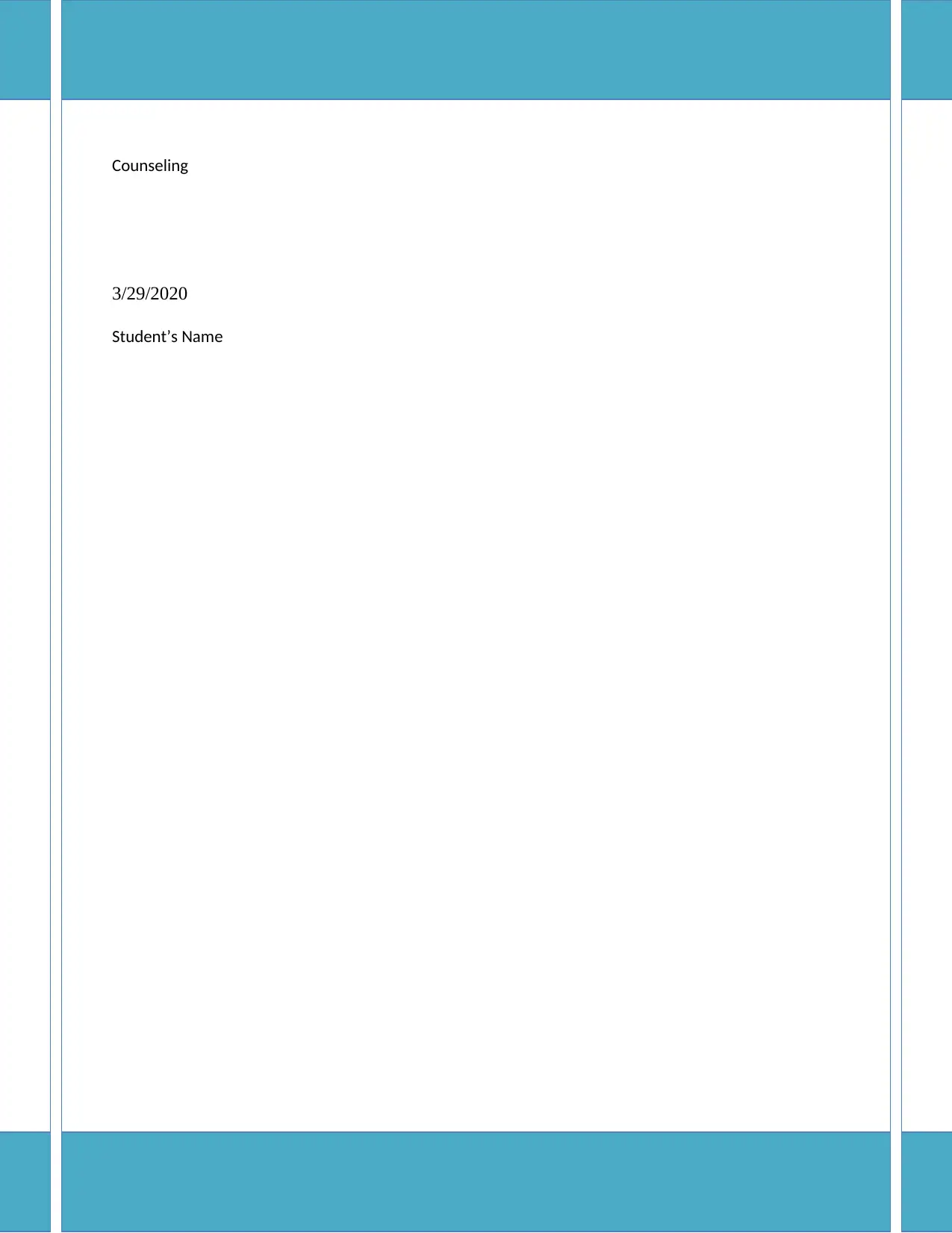
Running Head: BUSINESS AND CORPORATION LAW 0
Counseling
3/29/2020
Student’s Name
Counseling
3/29/2020
Student’s Name
Paraphrase This Document
Need a fresh take? Get an instant paraphrase of this document with our AI Paraphraser
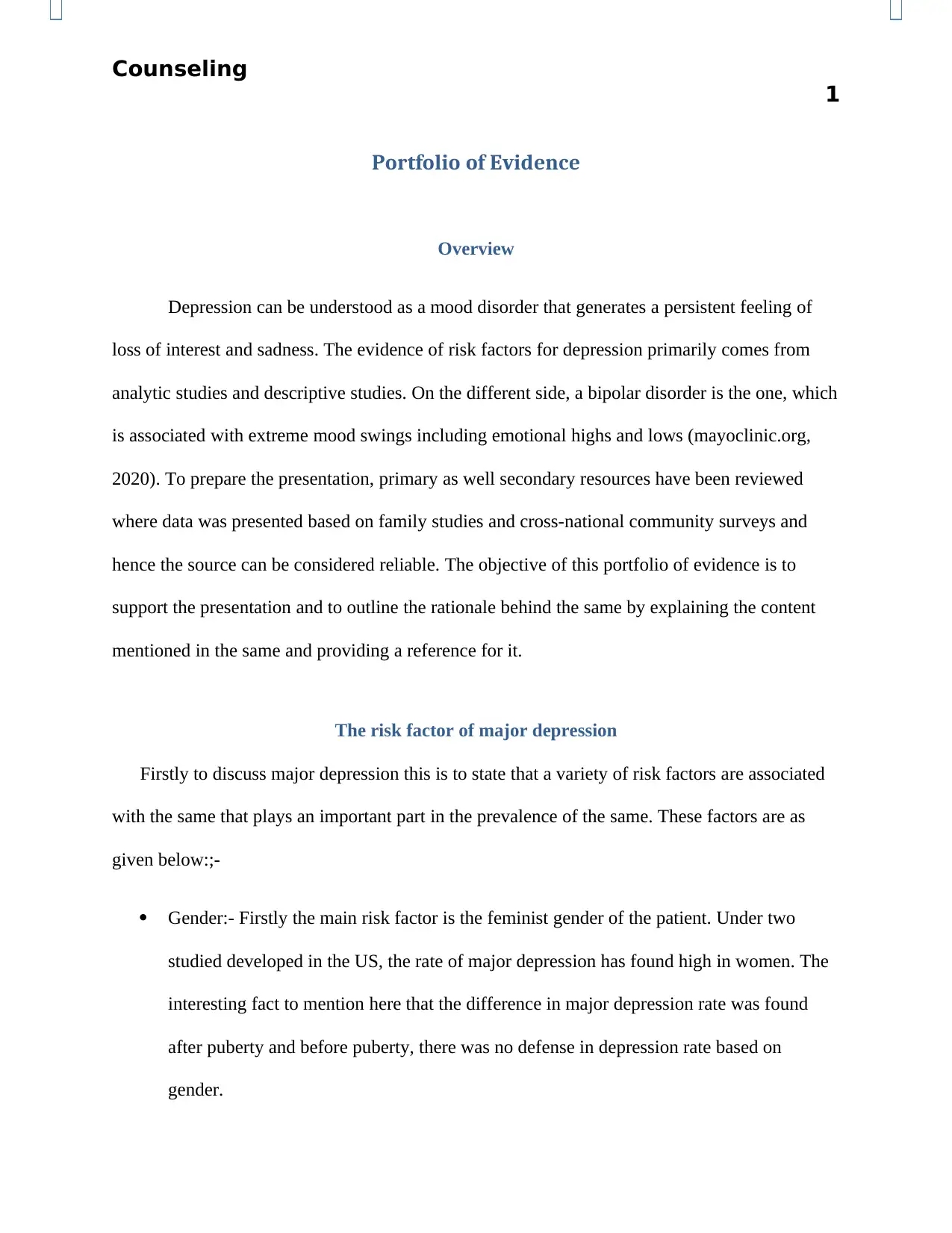
Counseling
1
Portfolio of Evidence
Overview
Depression can be understood as a mood disorder that generates a persistent feeling of
loss of interest and sadness. The evidence of risk factors for depression primarily comes from
analytic studies and descriptive studies. On the different side, a bipolar disorder is the one, which
is associated with extreme mood swings including emotional highs and lows (mayoclinic.org,
2020). To prepare the presentation, primary as well secondary resources have been reviewed
where data was presented based on family studies and cross-national community surveys and
hence the source can be considered reliable. The objective of this portfolio of evidence is to
support the presentation and to outline the rationale behind the same by explaining the content
mentioned in the same and providing a reference for it.
The risk factor of major depression
Firstly to discuss major depression this is to state that a variety of risk factors are associated
with the same that plays an important part in the prevalence of the same. These factors are as
given below:;-
Gender:- Firstly the main risk factor is the feminist gender of the patient. Under two
studied developed in the US, the rate of major depression has found high in women. The
interesting fact to mention here that the difference in major depression rate was found
after puberty and before puberty, there was no defense in depression rate based on
gender.
1
Portfolio of Evidence
Overview
Depression can be understood as a mood disorder that generates a persistent feeling of
loss of interest and sadness. The evidence of risk factors for depression primarily comes from
analytic studies and descriptive studies. On the different side, a bipolar disorder is the one, which
is associated with extreme mood swings including emotional highs and lows (mayoclinic.org,
2020). To prepare the presentation, primary as well secondary resources have been reviewed
where data was presented based on family studies and cross-national community surveys and
hence the source can be considered reliable. The objective of this portfolio of evidence is to
support the presentation and to outline the rationale behind the same by explaining the content
mentioned in the same and providing a reference for it.
The risk factor of major depression
Firstly to discuss major depression this is to state that a variety of risk factors are associated
with the same that plays an important part in the prevalence of the same. These factors are as
given below:;-
Gender:- Firstly the main risk factor is the feminist gender of the patient. Under two
studied developed in the US, the rate of major depression has found high in women. The
interesting fact to mention here that the difference in major depression rate was found
after puberty and before puberty, there was no defense in depression rate based on
gender.
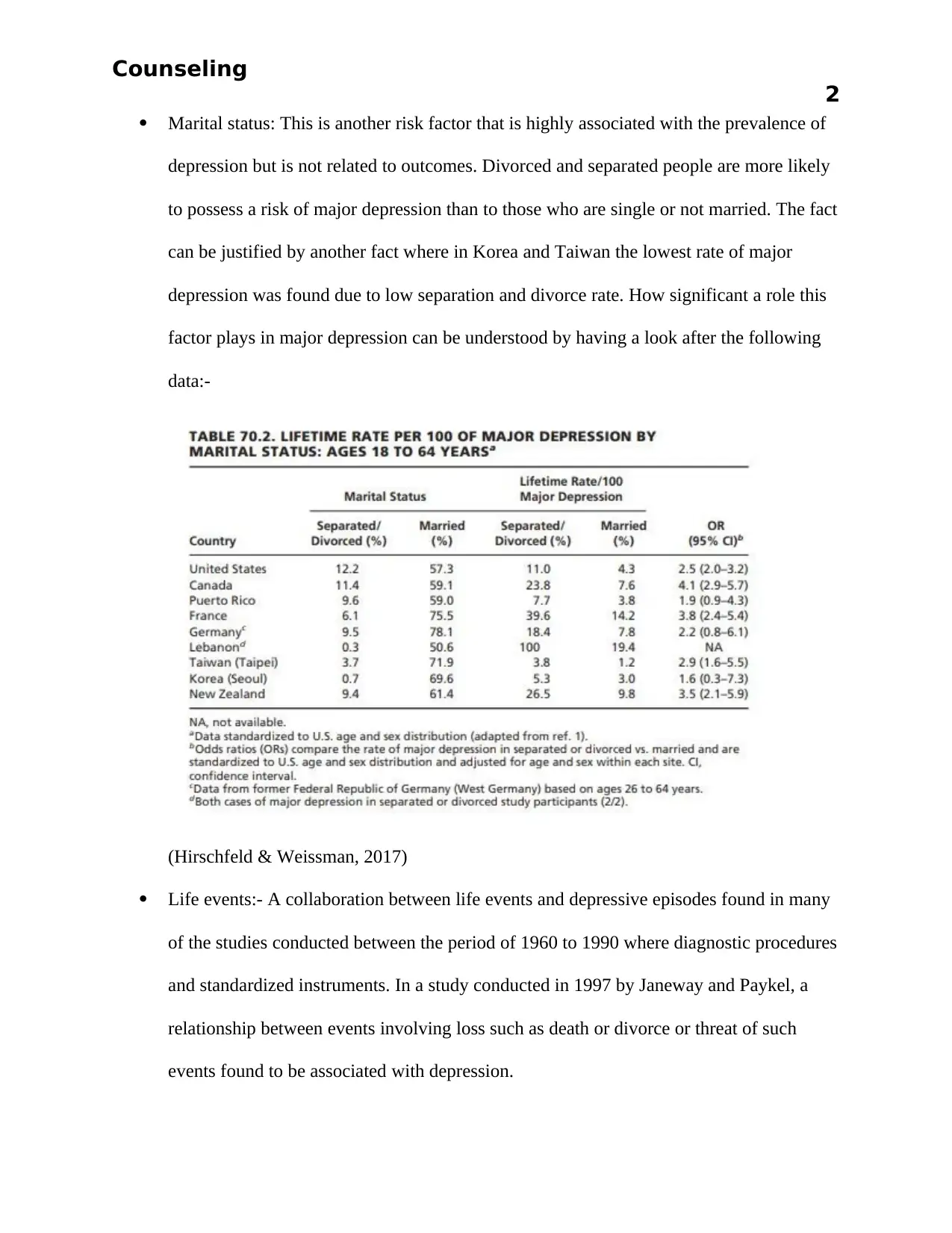
Counseling
2
Marital status: This is another risk factor that is highly associated with the prevalence of
depression but is not related to outcomes. Divorced and separated people are more likely
to possess a risk of major depression than to those who are single or not married. The fact
can be justified by another fact where in Korea and Taiwan the lowest rate of major
depression was found due to low separation and divorce rate. How significant a role this
factor plays in major depression can be understood by having a look after the following
data:-
(Hirschfeld & Weissman, 2017)
Life events:- A collaboration between life events and depressive episodes found in many
of the studies conducted between the period of 1960 to 1990 where diagnostic procedures
and standardized instruments. In a study conducted in 1997 by Janeway and Paykel, a
relationship between events involving loss such as death or divorce or threat of such
events found to be associated with depression.
2
Marital status: This is another risk factor that is highly associated with the prevalence of
depression but is not related to outcomes. Divorced and separated people are more likely
to possess a risk of major depression than to those who are single or not married. The fact
can be justified by another fact where in Korea and Taiwan the lowest rate of major
depression was found due to low separation and divorce rate. How significant a role this
factor plays in major depression can be understood by having a look after the following
data:-
(Hirschfeld & Weissman, 2017)
Life events:- A collaboration between life events and depressive episodes found in many
of the studies conducted between the period of 1960 to 1990 where diagnostic procedures
and standardized instruments. In a study conducted in 1997 by Janeway and Paykel, a
relationship between events involving loss such as death or divorce or threat of such
events found to be associated with depression.
⊘ This is a preview!⊘
Do you want full access?
Subscribe today to unlock all pages.

Trusted by 1+ million students worldwide
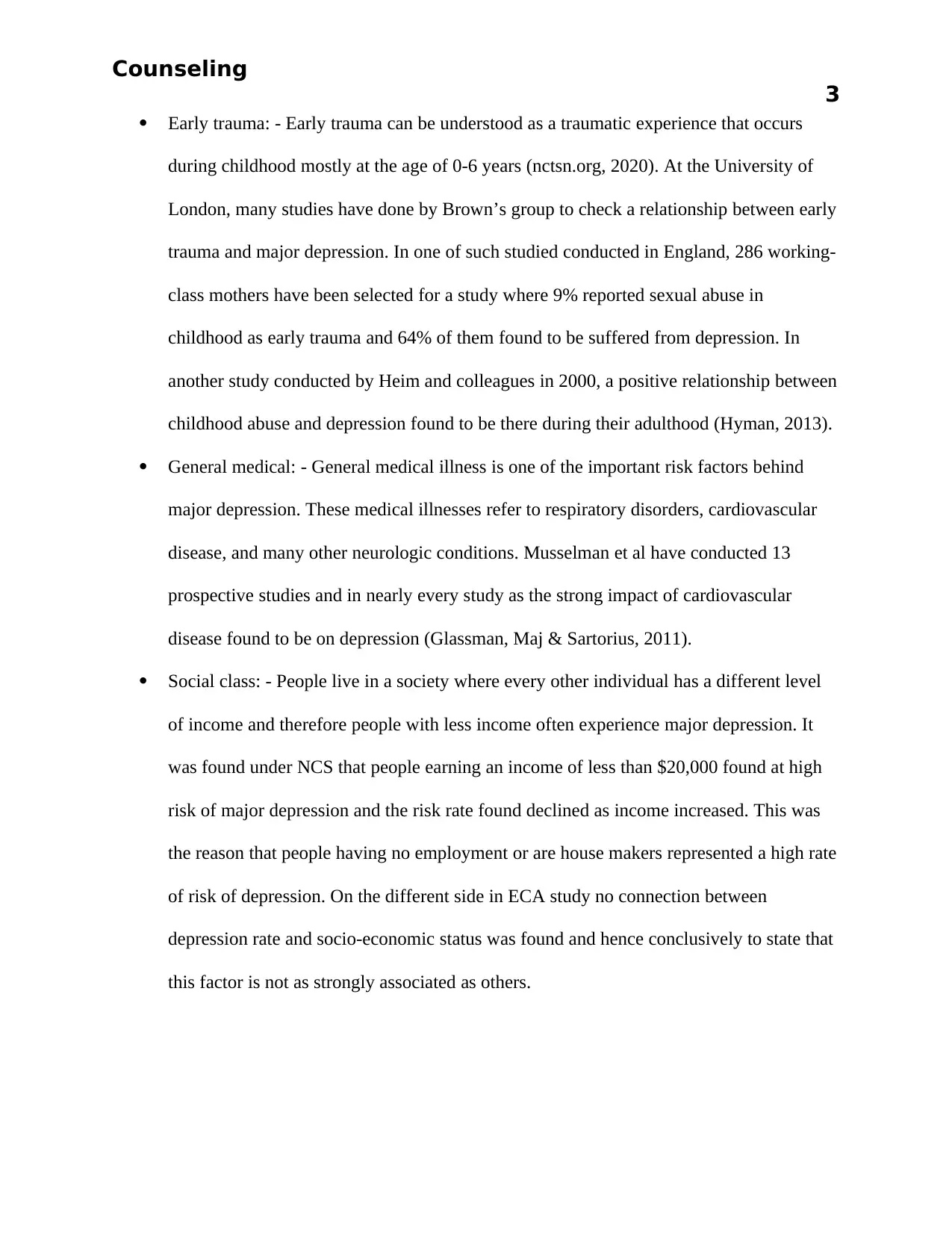
Counseling
3
Early trauma: - Early trauma can be understood as a traumatic experience that occurs
during childhood mostly at the age of 0-6 years (nctsn.org, 2020). At the University of
London, many studies have done by Brown’s group to check a relationship between early
trauma and major depression. In one of such studied conducted in England, 286 working-
class mothers have been selected for a study where 9% reported sexual abuse in
childhood as early trauma and 64% of them found to be suffered from depression. In
another study conducted by Heim and colleagues in 2000, a positive relationship between
childhood abuse and depression found to be there during their adulthood (Hyman, 2013).
General medical: - General medical illness is one of the important risk factors behind
major depression. These medical illnesses refer to respiratory disorders, cardiovascular
disease, and many other neurologic conditions. Musselman et al have conducted 13
prospective studies and in nearly every study as the strong impact of cardiovascular
disease found to be on depression (Glassman, Maj & Sartorius, 2011).
Social class: - People live in a society where every other individual has a different level
of income and therefore people with less income often experience major depression. It
was found under NCS that people earning an income of less than $20,000 found at high
risk of major depression and the risk rate found declined as income increased. This was
the reason that people having no employment or are house makers represented a high rate
of risk of depression. On the different side in ECA study no connection between
depression rate and socio-economic status was found and hence conclusively to state that
this factor is not as strongly associated as others.
3
Early trauma: - Early trauma can be understood as a traumatic experience that occurs
during childhood mostly at the age of 0-6 years (nctsn.org, 2020). At the University of
London, many studies have done by Brown’s group to check a relationship between early
trauma and major depression. In one of such studied conducted in England, 286 working-
class mothers have been selected for a study where 9% reported sexual abuse in
childhood as early trauma and 64% of them found to be suffered from depression. In
another study conducted by Heim and colleagues in 2000, a positive relationship between
childhood abuse and depression found to be there during their adulthood (Hyman, 2013).
General medical: - General medical illness is one of the important risk factors behind
major depression. These medical illnesses refer to respiratory disorders, cardiovascular
disease, and many other neurologic conditions. Musselman et al have conducted 13
prospective studies and in nearly every study as the strong impact of cardiovascular
disease found to be on depression (Glassman, Maj & Sartorius, 2011).
Social class: - People live in a society where every other individual has a different level
of income and therefore people with less income often experience major depression. It
was found under NCS that people earning an income of less than $20,000 found at high
risk of major depression and the risk rate found declined as income increased. This was
the reason that people having no employment or are house makers represented a high rate
of risk of depression. On the different side in ECA study no connection between
depression rate and socio-economic status was found and hence conclusively to state that
this factor is not as strongly associated as others.
Paraphrase This Document
Need a fresh take? Get an instant paraphrase of this document with our AI Paraphraser
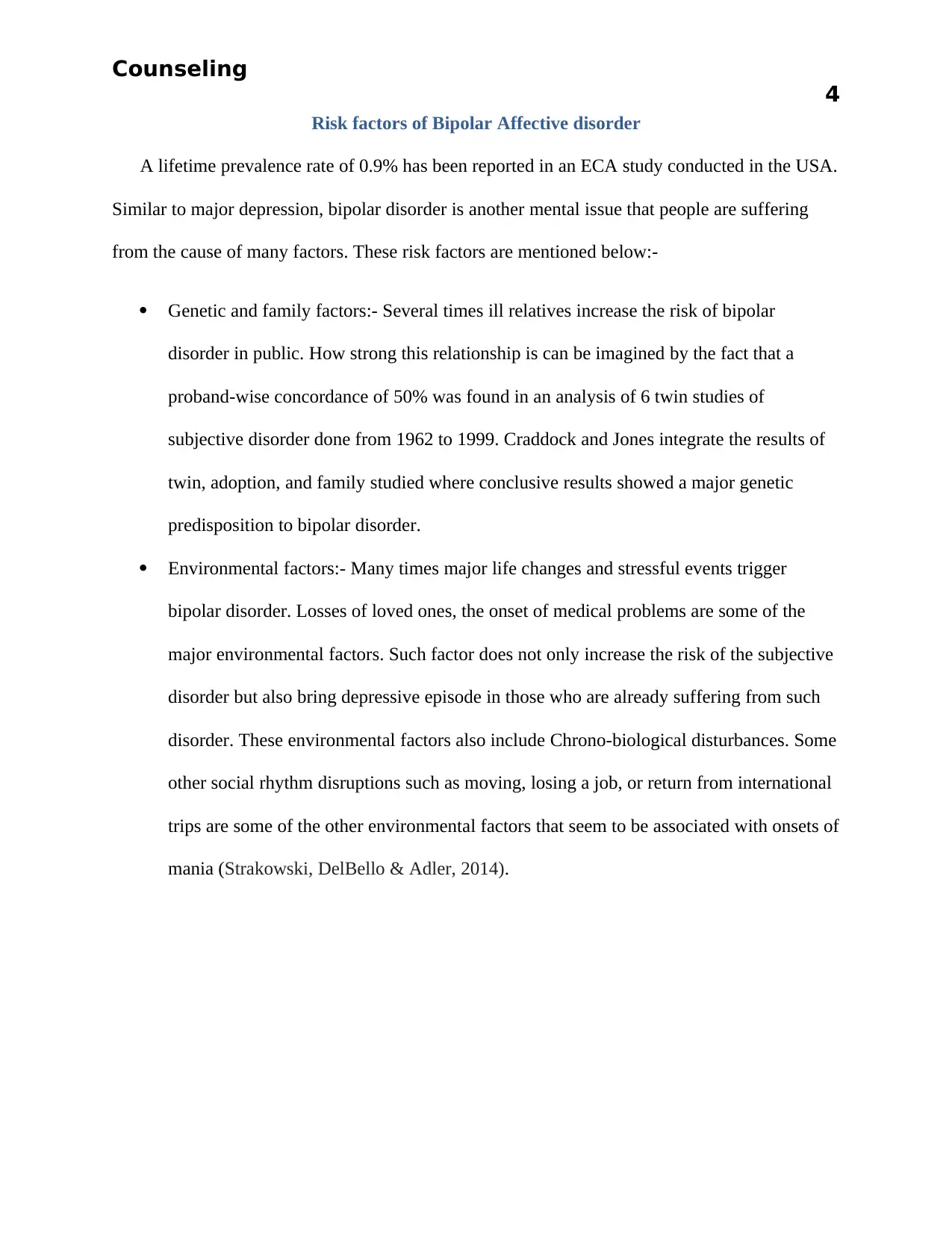
Counseling
4
Risk factors of Bipolar Affective disorder
A lifetime prevalence rate of 0.9% has been reported in an ECA study conducted in the USA.
Similar to major depression, bipolar disorder is another mental issue that people are suffering
from the cause of many factors. These risk factors are mentioned below:-
Genetic and family factors:- Several times ill relatives increase the risk of bipolar
disorder in public. How strong this relationship is can be imagined by the fact that a
proband-wise concordance of 50% was found in an analysis of 6 twin studies of
subjective disorder done from 1962 to 1999. Craddock and Jones integrate the results of
twin, adoption, and family studied where conclusive results showed a major genetic
predisposition to bipolar disorder.
Environmental factors:- Many times major life changes and stressful events trigger
bipolar disorder. Losses of loved ones, the onset of medical problems are some of the
major environmental factors. Such factor does not only increase the risk of the subjective
disorder but also bring depressive episode in those who are already suffering from such
disorder. These environmental factors also include Chrono-biological disturbances. Some
other social rhythm disruptions such as moving, losing a job, or return from international
trips are some of the other environmental factors that seem to be associated with onsets of
mania (Strakowski, DelBello & Adler, 2014).
4
Risk factors of Bipolar Affective disorder
A lifetime prevalence rate of 0.9% has been reported in an ECA study conducted in the USA.
Similar to major depression, bipolar disorder is another mental issue that people are suffering
from the cause of many factors. These risk factors are mentioned below:-
Genetic and family factors:- Several times ill relatives increase the risk of bipolar
disorder in public. How strong this relationship is can be imagined by the fact that a
proband-wise concordance of 50% was found in an analysis of 6 twin studies of
subjective disorder done from 1962 to 1999. Craddock and Jones integrate the results of
twin, adoption, and family studied where conclusive results showed a major genetic
predisposition to bipolar disorder.
Environmental factors:- Many times major life changes and stressful events trigger
bipolar disorder. Losses of loved ones, the onset of medical problems are some of the
major environmental factors. Such factor does not only increase the risk of the subjective
disorder but also bring depressive episode in those who are already suffering from such
disorder. These environmental factors also include Chrono-biological disturbances. Some
other social rhythm disruptions such as moving, losing a job, or return from international
trips are some of the other environmental factors that seem to be associated with onsets of
mania (Strakowski, DelBello & Adler, 2014).
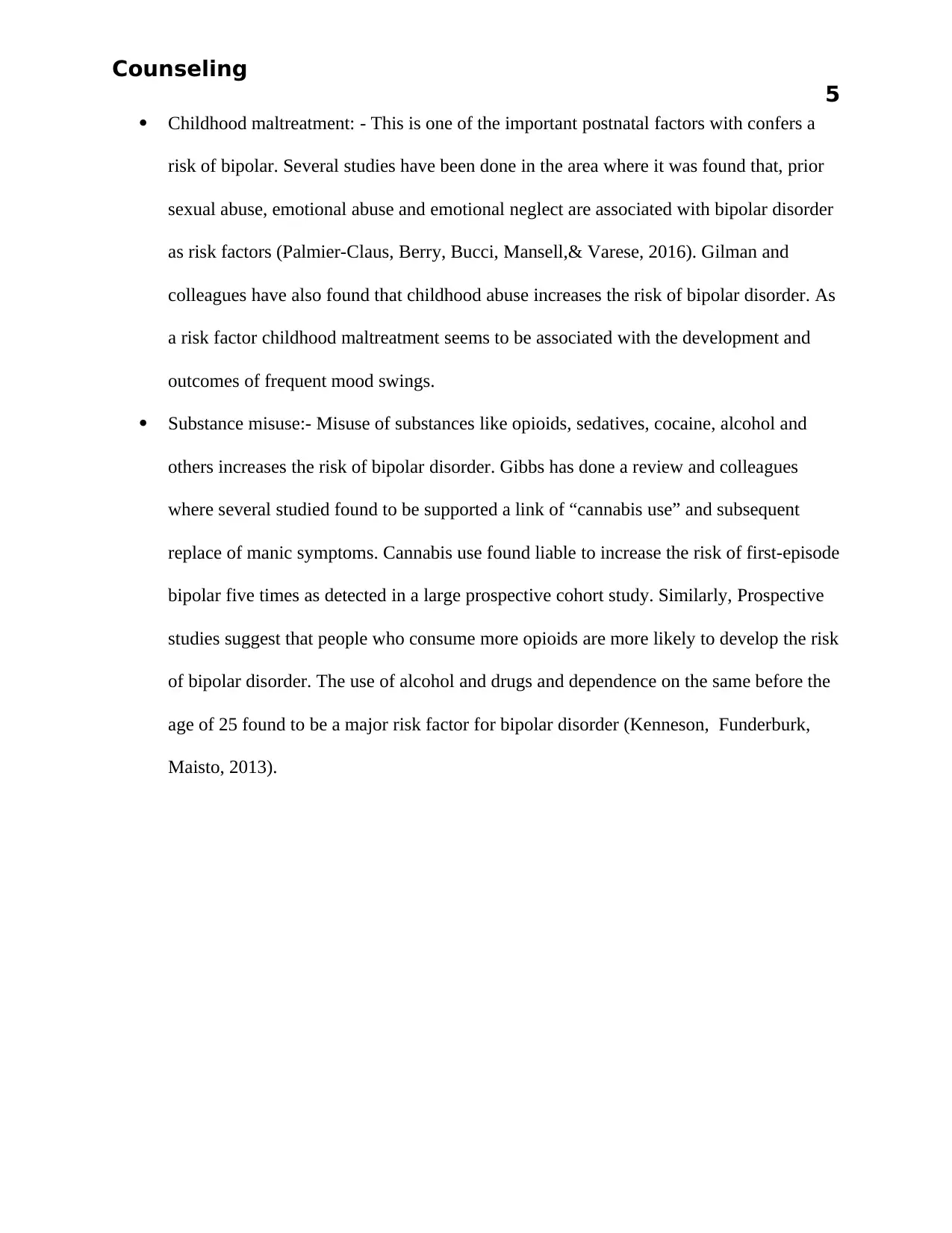
Counseling
5
Childhood maltreatment: - This is one of the important postnatal factors with confers a
risk of bipolar. Several studies have been done in the area where it was found that, prior
sexual abuse, emotional abuse and emotional neglect are associated with bipolar disorder
as risk factors (Palmier-Claus, Berry, Bucci, Mansell,& Varese, 2016). Gilman and
colleagues have also found that childhood abuse increases the risk of bipolar disorder. As
a risk factor childhood maltreatment seems to be associated with the development and
outcomes of frequent mood swings.
Substance misuse:- Misuse of substances like opioids, sedatives, cocaine, alcohol and
others increases the risk of bipolar disorder. Gibbs has done a review and colleagues
where several studied found to be supported a link of “cannabis use” and subsequent
replace of manic symptoms. Cannabis use found liable to increase the risk of first-episode
bipolar five times as detected in a large prospective cohort study. Similarly, Prospective
studies suggest that people who consume more opioids are more likely to develop the risk
of bipolar disorder. The use of alcohol and drugs and dependence on the same before the
age of 25 found to be a major risk factor for bipolar disorder (Kenneson, Funderburk,
Maisto, 2013).
5
Childhood maltreatment: - This is one of the important postnatal factors with confers a
risk of bipolar. Several studies have been done in the area where it was found that, prior
sexual abuse, emotional abuse and emotional neglect are associated with bipolar disorder
as risk factors (Palmier-Claus, Berry, Bucci, Mansell,& Varese, 2016). Gilman and
colleagues have also found that childhood abuse increases the risk of bipolar disorder. As
a risk factor childhood maltreatment seems to be associated with the development and
outcomes of frequent mood swings.
Substance misuse:- Misuse of substances like opioids, sedatives, cocaine, alcohol and
others increases the risk of bipolar disorder. Gibbs has done a review and colleagues
where several studied found to be supported a link of “cannabis use” and subsequent
replace of manic symptoms. Cannabis use found liable to increase the risk of first-episode
bipolar five times as detected in a large prospective cohort study. Similarly, Prospective
studies suggest that people who consume more opioids are more likely to develop the risk
of bipolar disorder. The use of alcohol and drugs and dependence on the same before the
age of 25 found to be a major risk factor for bipolar disorder (Kenneson, Funderburk,
Maisto, 2013).
⊘ This is a preview!⊘
Do you want full access?
Subscribe today to unlock all pages.

Trusted by 1+ million students worldwide
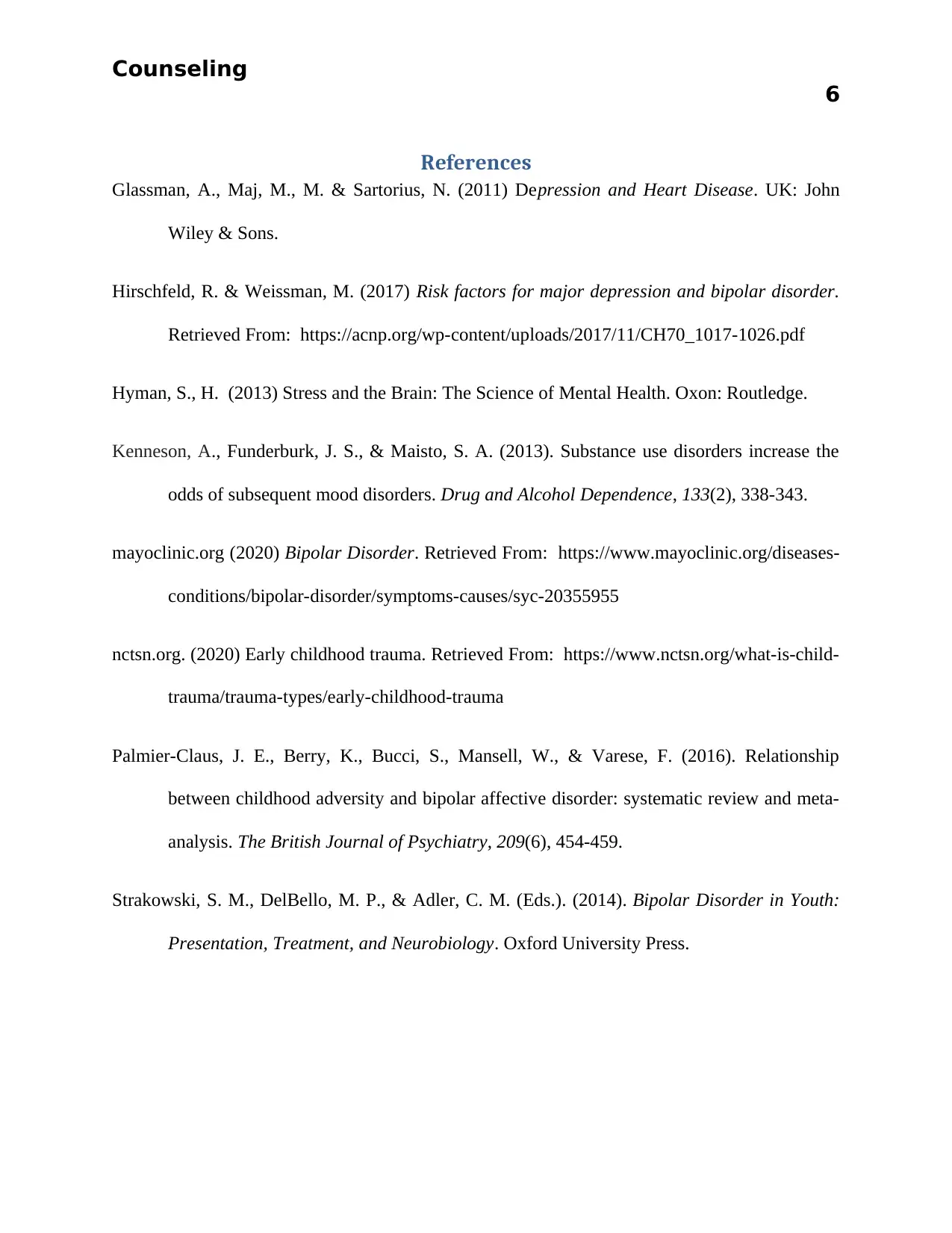
Counseling
6
References
Glassman, A., Maj, M., M. & Sartorius, N. (2011) Depression and Heart Disease. UK: John
Wiley & Sons.
Hirschfeld, R. & Weissman, M. (2017) Risk factors for major depression and bipolar disorder.
Retrieved From: https://acnp.org/wp-content/uploads/2017/11/CH70_1017-1026.pdf
Hyman, S., H. (2013) Stress and the Brain: The Science of Mental Health. Oxon: Routledge.
Kenneson, A., Funderburk, J. S., & Maisto, S. A. (2013). Substance use disorders increase the
odds of subsequent mood disorders. Drug and Alcohol Dependence, 133(2), 338-343.
mayoclinic.org (2020) Bipolar Disorder. Retrieved From: https://www.mayoclinic.org/diseases-
conditions/bipolar-disorder/symptoms-causes/syc-20355955
nctsn.org. (2020) Early childhood trauma. Retrieved From: https://www.nctsn.org/what-is-child-
trauma/trauma-types/early-childhood-trauma
Palmier-Claus, J. E., Berry, K., Bucci, S., Mansell, W., & Varese, F. (2016). Relationship
between childhood adversity and bipolar affective disorder: systematic review and meta-
analysis. The British Journal of Psychiatry, 209(6), 454-459.
Strakowski, S. M., DelBello, M. P., & Adler, C. M. (Eds.). (2014). Bipolar Disorder in Youth:
Presentation, Treatment, and Neurobiology. Oxford University Press.
6
References
Glassman, A., Maj, M., M. & Sartorius, N. (2011) Depression and Heart Disease. UK: John
Wiley & Sons.
Hirschfeld, R. & Weissman, M. (2017) Risk factors for major depression and bipolar disorder.
Retrieved From: https://acnp.org/wp-content/uploads/2017/11/CH70_1017-1026.pdf
Hyman, S., H. (2013) Stress and the Brain: The Science of Mental Health. Oxon: Routledge.
Kenneson, A., Funderburk, J. S., & Maisto, S. A. (2013). Substance use disorders increase the
odds of subsequent mood disorders. Drug and Alcohol Dependence, 133(2), 338-343.
mayoclinic.org (2020) Bipolar Disorder. Retrieved From: https://www.mayoclinic.org/diseases-
conditions/bipolar-disorder/symptoms-causes/syc-20355955
nctsn.org. (2020) Early childhood trauma. Retrieved From: https://www.nctsn.org/what-is-child-
trauma/trauma-types/early-childhood-trauma
Palmier-Claus, J. E., Berry, K., Bucci, S., Mansell, W., & Varese, F. (2016). Relationship
between childhood adversity and bipolar affective disorder: systematic review and meta-
analysis. The British Journal of Psychiatry, 209(6), 454-459.
Strakowski, S. M., DelBello, M. P., & Adler, C. M. (Eds.). (2014). Bipolar Disorder in Youth:
Presentation, Treatment, and Neurobiology. Oxford University Press.
1 out of 7
Related Documents
Your All-in-One AI-Powered Toolkit for Academic Success.
+13062052269
info@desklib.com
Available 24*7 on WhatsApp / Email
![[object Object]](/_next/static/media/star-bottom.7253800d.svg)
Unlock your academic potential
Copyright © 2020–2025 A2Z Services. All Rights Reserved. Developed and managed by ZUCOL.





